Abstract
We have collected peak expiratory flow rates, one-second forced expiratory volumes, and forced vital capacities in sets of 10 or 20 values at one-minute intervals from 30 normal, 49 asthmatic, and 26 bronchitic subjects. Analysis shows that the derivatives are compatible with a normal distribution of the values in the sets, so that the true value is best represented by the arithmetic mean of all valid attempts. One-third of all subjects showed skewness in one or more indices but these were equally divided between positive and negative directions. There is no sign of the dominant negative skewness that would result if the true value was indeed a maximum, which could be approached or equalled but never exceeded. There is no sign that repetition worsens performance. Seventy-two subjects showed no regression in any index and those of the remainder who deteriorated were balanced by equal numbers in all categories who improved. There is a significant tendency for both the highest and the lowest values to occur in the earlier part of any series. Probability theory suggests that this is a statistical phenomenon. The best estimate of the true value of these indices is probably the mean of as many observations as can be conveniently obtained and the data can be treated statistically as if they were a sample from a normally distributed population.
Full text
PDF
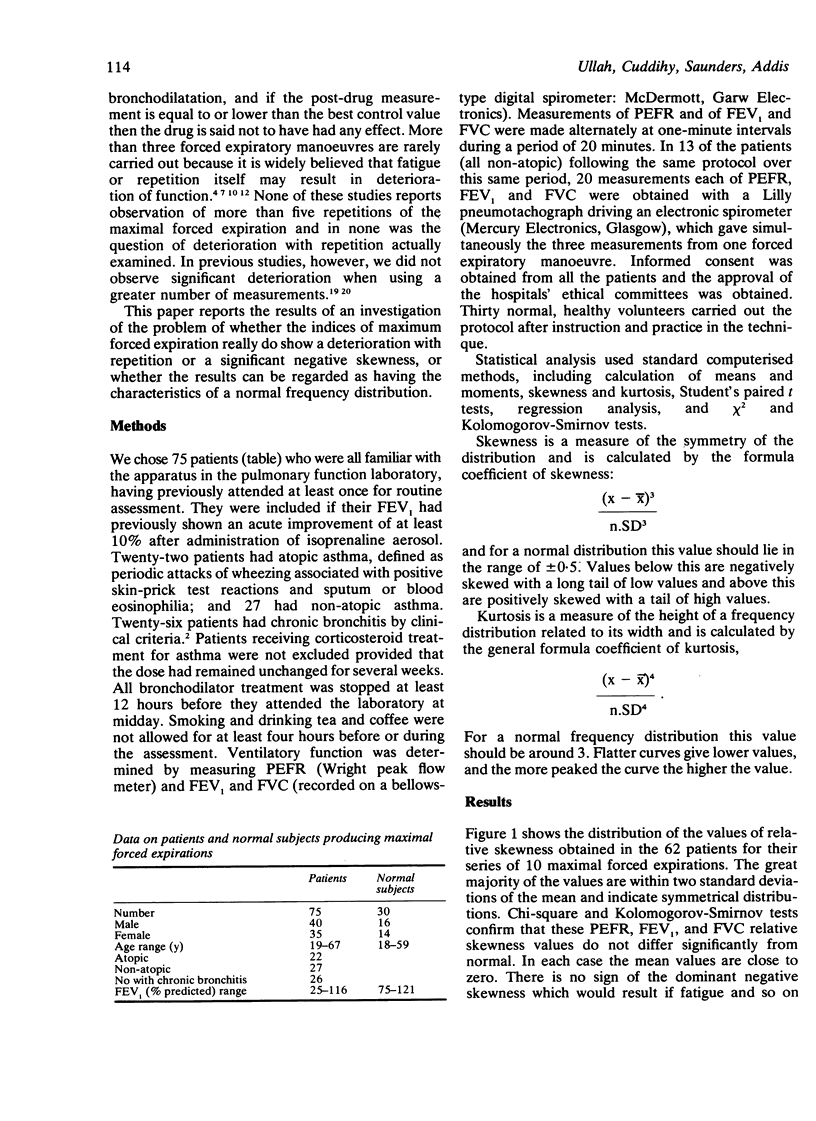
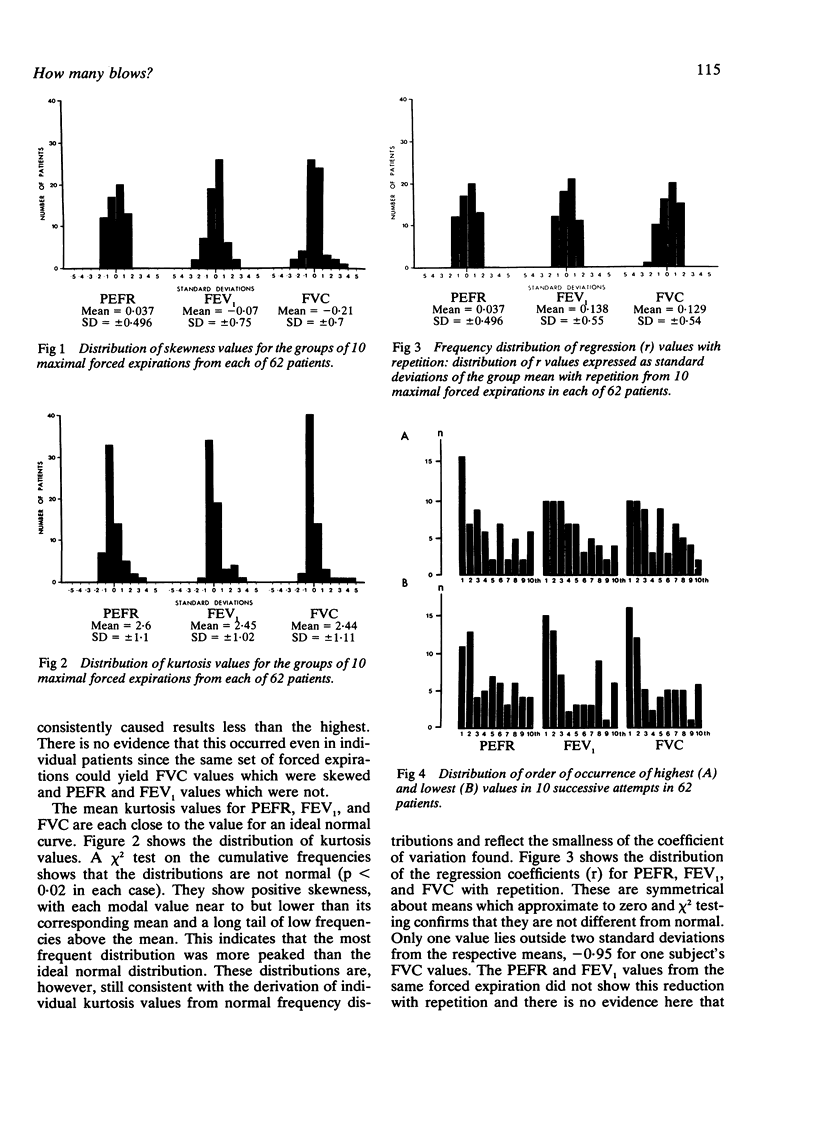
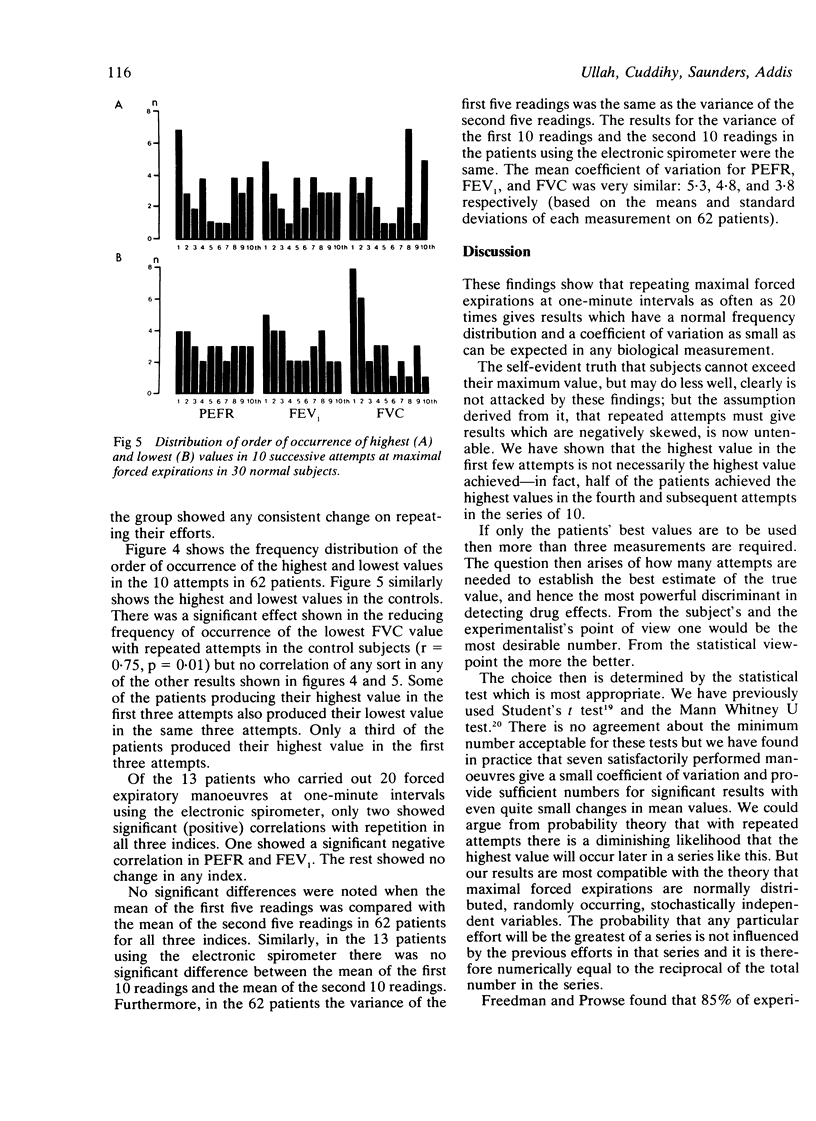
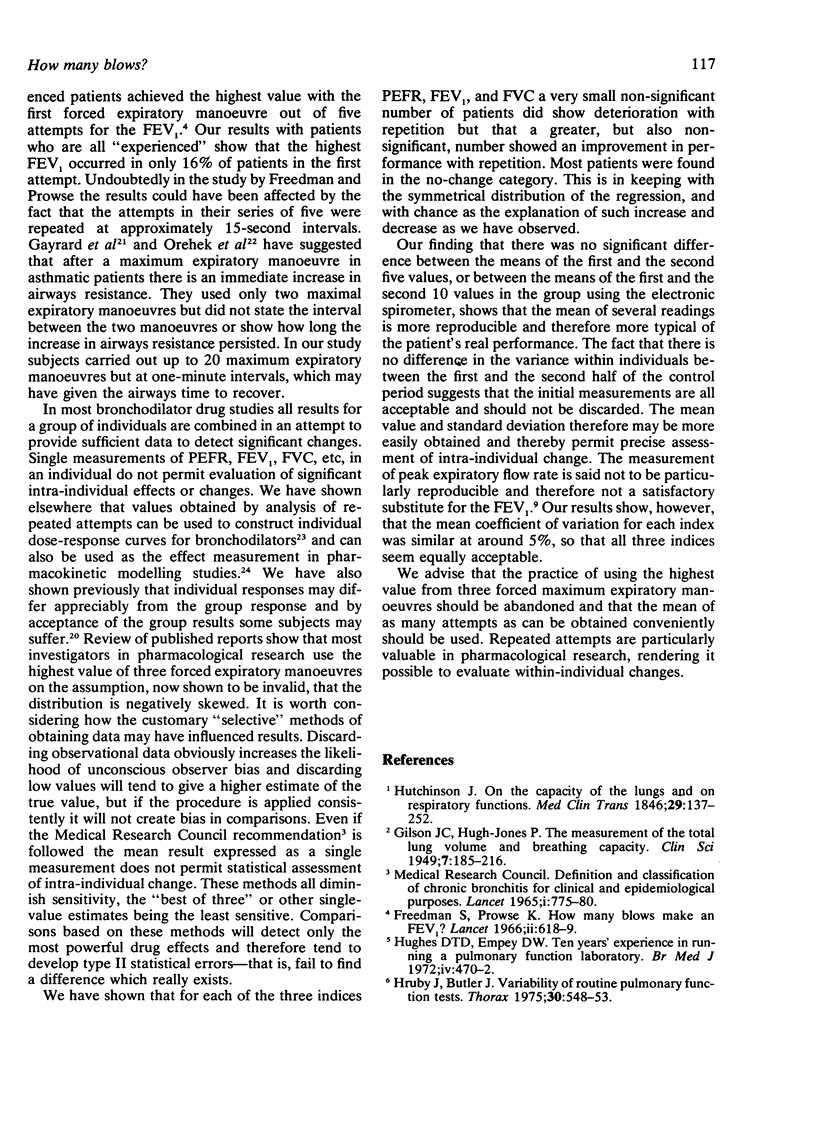
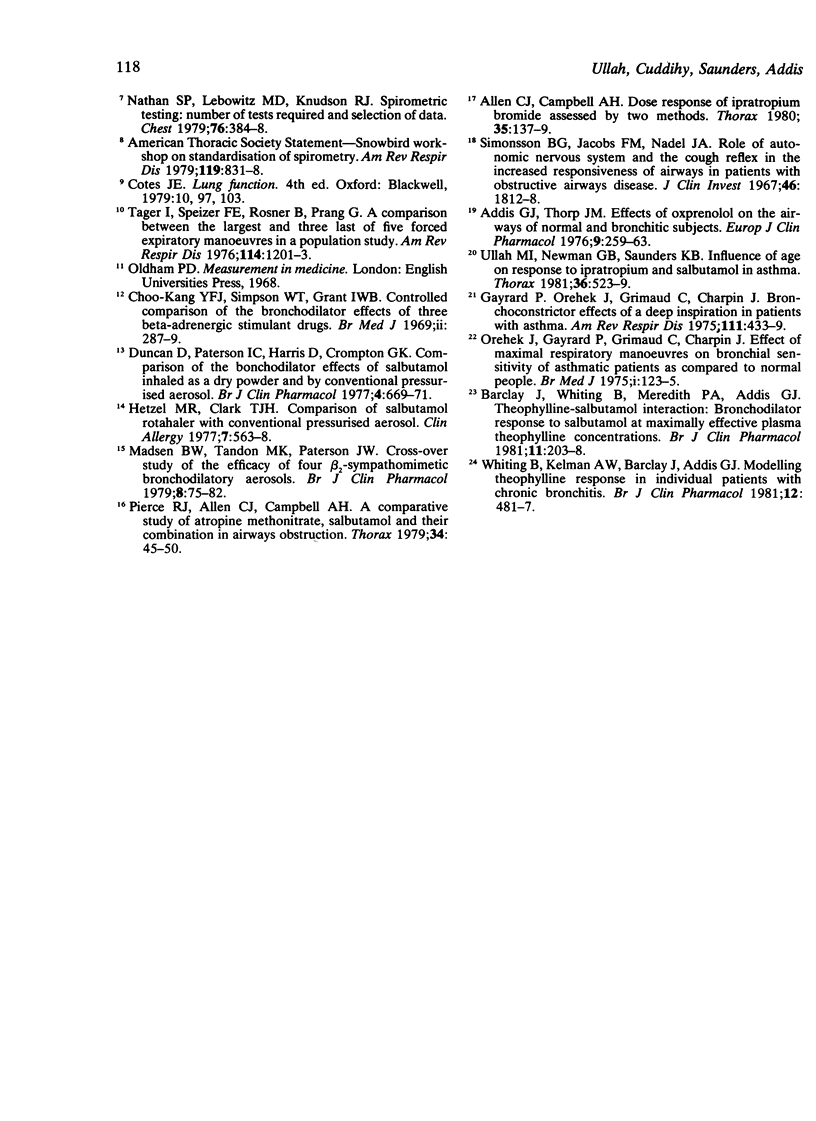
Selected References
These references are in PubMed. This may not be the complete list of references from this article.
- Addis G. J., Thorp J. M. Effects of oxprenolol on the airways of normal and bronchitic subjects. Eur J Clin Pharmacol. 1976 Feb 6;9(4):259–263. doi: 10.1007/BF00561658. [DOI] [PubMed] [Google Scholar]
- Allen C. J., Campbell A. H. Dose response of ipratropium assessed by two methods. Thorax. 1980 Feb;35(2):137–139. doi: 10.1136/thx.35.2.137. [DOI] [PMC free article] [PubMed] [Google Scholar]
- Barclay J., Whiting B., Meredith P. A., Addis G. J. Theophylline-salbutamol interaction: bronchodilator response to salbutamol at maximally effective plasma theophylline concentrations. Br J Clin Pharmacol. 1981 Feb;11(2):203–208. doi: 10.1111/j.1365-2125.1981.tb01125.x. [DOI] [PMC free article] [PubMed] [Google Scholar]
- Choo-Kang Y. F., Simpson W. T., Grant I. W. Controlled comparison of the bronchodilator effects of three beta-adrenergic stimulant drugs administered by inhalation to patients with asthma. Br Med J. 1969 May 3;2(5652):287–289. doi: 10.1136/bmj.2.5652.287. [DOI] [PMC free article] [PubMed] [Google Scholar]
- Freedman S., Prowse K. How many blows make an F.E.V.1.0? Lancet. 1966 Sep 17;2(7464):618–619. doi: 10.1016/s0140-6736(66)91928-3. [DOI] [PubMed] [Google Scholar]
- Gayrard P., Orehek J., Grimaud C., CHarpin J. Bronchoconstrictor effects of a deep inspiration in patients with asthma. Am Rev Respir Dis. 1975 Apr;111(4):433–439. doi: 10.1164/arrd.1975.111.4.433. [DOI] [PubMed] [Google Scholar]
- Hetzel M. R., Clark T. J. Comparison of salbutamol Rotahaler with conventional pressurized aerosol. Clin Allergy. 1977 Nov;7(6):563–568. doi: 10.1111/j.1365-2222.1977.tb01486.x. [DOI] [PubMed] [Google Scholar]
- Hruby J., Butler J. Variability of routine pulmonary function tests. Thorax. 1975 Oct;30(5):548–553. doi: 10.1136/thx.30.5.548. [DOI] [PMC free article] [PubMed] [Google Scholar]
- Hughes D. T., Empey D. W. Ten years' experience in running a pulmonary function laboratory. Br Med J. 1972 Nov 25;4(5838):470–473. doi: 10.1136/bmj.4.5838.470. [DOI] [PMC free article] [PubMed] [Google Scholar]
- Madsen B. W., Tandon M. K., Paterson J. W. Cross-over study of the efficacy of four beta 2-sympathomimetic bronchodilator aerosols. Br J Clin Pharmacol. 1979 Jul;8(1):75–82. doi: 10.1111/j.1365-2125.1979.tb05912.x. [DOI] [PMC free article] [PubMed] [Google Scholar]
- Nathan S. P., Lebowitz M. D., Knudson R. J. Spirometric testing. Number of tests required and selection of data. Chest. 1979 Oct;76(4):384–388. doi: 10.1378/chest.76.4.384. [DOI] [PubMed] [Google Scholar]
- Orehek J., Gayrard P., Grimaud C., Charpin J. Effect of maximal respiratory manoeuvres on bronchial sensitivity of asthmatic patients as compared to normal people. Br Med J. 1975 Jan 18;1(5950):123–125. doi: 10.1136/bmj.1.5950.123. [DOI] [PMC free article] [PubMed] [Google Scholar]
- Pierce R. J., Allen C. J., Campbell A. H. A comparative study of atropine methonitrate, salbutamol, and their combination in airways obstruction. Thorax. 1979 Feb;34(1):45–50. doi: 10.1136/thx.34.1.45. [DOI] [PMC free article] [PubMed] [Google Scholar]
- Simonsson B. G., Jacobs F. M., Nadel J. A. Role of autonomic nervous system and the cough reflex in the increased responsiveness of airways in patients with obstructive airway disease. J Clin Invest. 1967 Nov;46(11):1812–1818. doi: 10.1172/JCI105671. [DOI] [PMC free article] [PubMed] [Google Scholar]
- Tager I., Speizer F. E., Rosner B., Prang G. A comparison between the three largest and three last of five forced expiratory maneuvers in a population study. Am Rev Respir Dis. 1976 Dec;114(6):1201–1203. doi: 10.1164/arrd.1976.114.6.1201. [DOI] [PubMed] [Google Scholar]
- Ullah M. I., Newman G. B., Saunders K. B. Influence of age on response to ipratropium and salbutamol in asthma. Thorax. 1981 Jul;36(7):523–529. doi: 10.1136/thx.36.7.523. [DOI] [PMC free article] [PubMed] [Google Scholar]
- Whiting B., Kelman A. W., Barclay J., Addis G. J. Modelling theophylline response in individual patients with chronic bronchitis. Br J Clin Pharmacol. 1981 Oct;12(4):481–487. doi: 10.1111/j.1365-2125.1981.tb01254.x. [DOI] [PMC free article] [PubMed] [Google Scholar]


